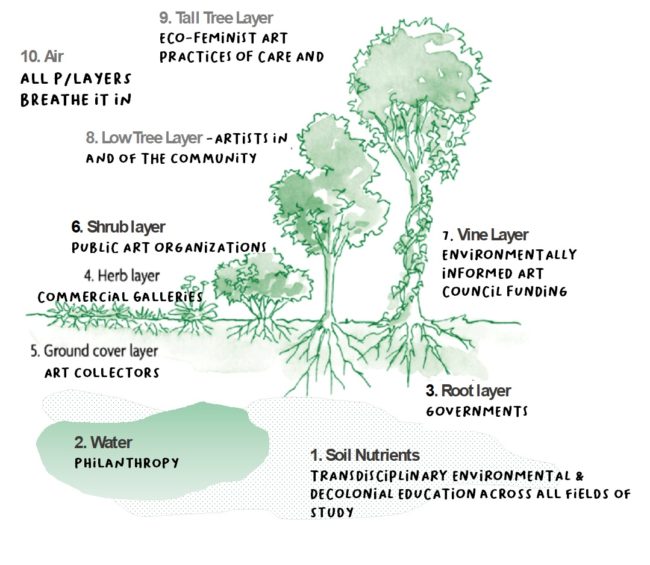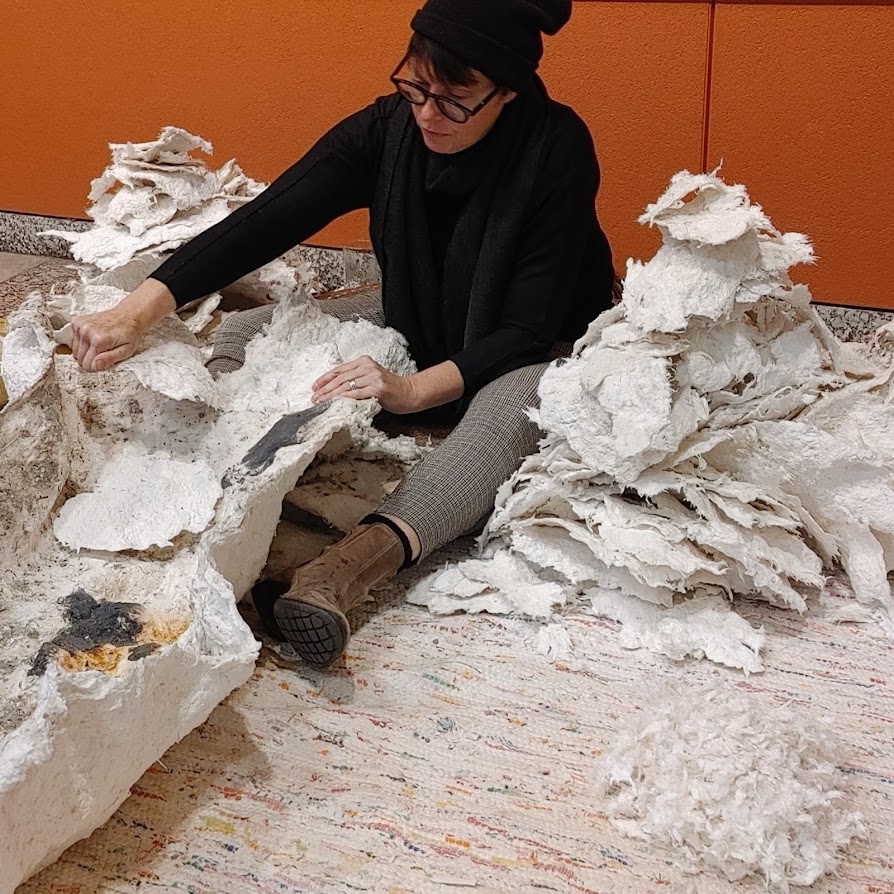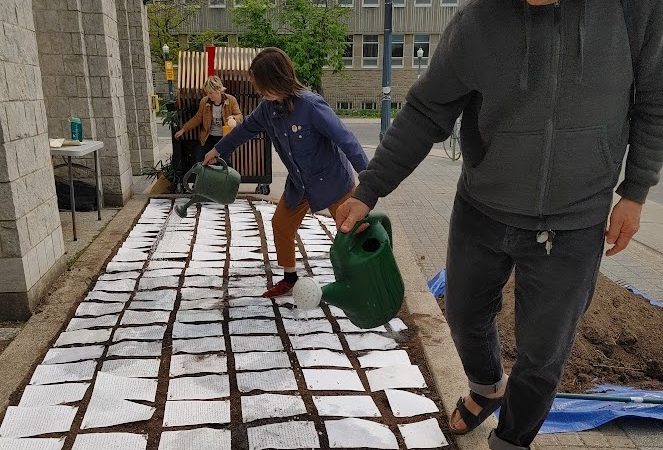Arising out of personal observations about how the art world contributes to the Anthropocene, which Dr. Natalie Loveless from the University of Alberta defines as a colonial, industrial capitalist, patriarchal and petrol phenomenon that I would add is made exponential by the globalization of Western thought that privileges economic growth and individual wealth over ecological justice and social equity, the UN/making Network is an assemblage of online platforms that support and promote interdisciplinary art forms that push beyond the production of objects for commodification and consumption and uptake methods of performativity to assist in the care and repair of ecological sites and spaces that support human and more-than-human well-being.

Figure 1: Jill Price, UN/making Network Website Homepage.
Formulated as a research-creation Ph.D. project in which I was interested in discovering and developing ways in which to unmake myself from systems of harm as a consumer and a maker, as well as transition my personal practice away from the narrative towards that which could be considered performative, preventative or reparative, the UN/making Network is Inspired by other artivist or cultural websites that work to share eco-ethical mandates, resources, and outcomes, and build a community of like-minded thinkers and doers. Temporarily housed under www.jillpricestudios.ca, the UN/making Network currently exists as a series of web pages that:
- Outlines a definition and methodology of UN/making inspired by the United Nations 17 Sustainable Development, the United Nations Declaration of Rights of Indigenous Peoples (UNDRIP), and Canada’s Truth and Reconciliation Calls to Action,
- Provides a home base to the UN/maker Series, a collection of artist interviews in video, blog, and podcast formats that work to expand the definition of UN/making through different approaches to creating.
- Hosts a growing UN/making Dictionary inspired by other eco-ethical glossaries such as The Dictionary of the Undoing by John Freeman, the online Environmental Dictionary, and the Counter-Desecration: A Glossary for Writing in the Anthropoceneby Linda Russo and Marthe Reed,
- Shares personal projects that have arisen out of UN/making as a concept and process,
- Provides links to other websites and resources encouraging or stressing the importance of UN/making to imagine new worlds,
- Links to the UN/making Network YouTube Channel, Instagram Feed, Facebook Page, and LinkedIn profile; and
- Upon completion of my Ph.D. and the securing of further funding, will continue to promote other creatives critically up taking conceptual and physical modes and methods of UN/making and provide a digital reading list/library that helps to inform the socio-political and environmental need for more creatives to adapt and adopt more eco-ethical approaches to being and doing.
Also drawing on the wisdom of past activists and critical thinkers within the arts, the UN/making Network is home to an ever-adaptable UN/making Methodology.

Figure 2: Jill Price, Design for UN/making Methodology, 2023 (Background Source: Herbs and Wildflowers, Olga Korneeva, 371103653, Shutterstock).
Arrived at by deconstructing the visual arts through an eco-feminist lens as well as across socio-economic theories of de-alienation, decentring, degrowth, and decolonization to encourage an unsettling debate that problematizes making in times of ecological and socio-political strife, the UN/making Methodology takes its inspiration from previous manifestos that promote art as a verb (Situationist Manifesto by Guy Dubord), care (Maintenance Manifesto by Mierle Laderman Ukeles), performativity (Craftivism Manifesto by the Craftivism Collective), environmental thought (Eco-Art Manifesto, 2004 by Linda Weintraub and Skip Schuckmann) and degrowth (Degrowth Toolbox for Artists by Alexandra Papademetriou). Also informed by research into other eco-ethical creatives and their inherently collaborative or reparative practices, the UN/making Methodology offers a skeleton guide to visual artists and their constituent publics and institutions wanting to work more ethically with and for Land in the future, as well as provides a keystone to a much broader and longer list of methods and things that need UN/making in order to carefully consider and reconsider how one can continue to conceive and produce ‘art’ while resisting systems and processes of harm that keep us complicit in neo-liberal colonialisms that depend on the destruction of the planet and in turn mass extinction of more-than-human and human species.
By speculating how this might happen, the UN/making Network, passionate about artists who are working with and for plants, is also in the midst of exploring how systems and institutions of the visual arts might need to be UN/made in order to usher in and sustain a culture of UN/making/degrowth by putting forward the organization and functions of a forest to suggest a variety of reconfigurations so that eco-ethical ‘art’ emerges as the tall tree layer essential for sustaining and protecting all other levels of their multi-species eco-systems.

Figure 3: Jill Price, UN/making Network Reconfiguration and Succession Planning Proposal for an Eco-ethical Visual Art Sector in Canada (7 Layers of the Forest Garden illustration source).
Problematized due to the accelerated aesthetics of digital technologies and over-populated platforms that make it difficult to find or grow one’s tribe amidst the constant barrage of advertising and ‘art’ that does not reflect a culture of degrowth or respect for Land as a multi-species living body, future projects for the UN/making Network may include researching and using additional platforms to further curate and promote language, images and activities that celebrate and inspire hope, slowness, thoughtfulness, eco-ethical materialities and respect for more-than-human ontographies and Indigenous world views.
Having already delivered a series of collaborative workshops for adults around the concept of UN/making, and recognizing the importance of reconfiguring early education curriculum so that the youngest of artists will gain a broader understanding of what is needed from creatives to help nurture a culture of care and repair, I am also investigating how the UN/making Network will serve as an accessible archive in which educators across the primary, secondary and undergraduate platforms will be able to choose from a selection of lessons that will help to nurture a more eco-ethical and decolonial approach to image and object making.
Overall, the future goal of the UN/making Network is to research, share, model and promote how UN/making is a creative and generative act that replaces acts of negation, destruction and the regurgitation of apocalyptic imagery and thinking with the imagination and enactment of more ethical futurities where both humans and the more-than-human have equal opportunity and support to flourish.
 An instructor at Georgian College within the Museum and Gallery Studies program, Jill Price is a professional interdisciplinary Canadian artist and independent curator of German, Scottish, Welsh and unknown descent, grateful to be living, working and playing on the traditional territory of the Wendat Nation and Anishinaabeg people, in Barrie, Ontario. Price earned a BFA and BEd at Western University and an MFA in Interdisciplinary Art Media and Design at OCAD University in Toronto, Ontario. The recipient of a 2016 SSHRC national research grant and the 2017 Michael Smith Foreign Study Bursary for research into the ecological, social and psychological shadows of the global textile industry, Price was also awarded OCADU’s 2017 Research and Writing Award for her thesis Land as Archive: A Collection of Seen and Unseen Shadows. Having also received the 2018-19 Faculty of Arts and Science Dean’s Award for Environmental Justice from Queen’s University, Price was awarded a 2021 Faculty of Arts and Science Project-Based and Portfolio Ph.D. Research Grant, a 2021 /2022 Teaching Fellowship at Queen’s University, and a Social Sciences and Humanities Research Council PhD Fellowship while researching UN/making as a generative and reparative act.
An instructor at Georgian College within the Museum and Gallery Studies program, Jill Price is a professional interdisciplinary Canadian artist and independent curator of German, Scottish, Welsh and unknown descent, grateful to be living, working and playing on the traditional territory of the Wendat Nation and Anishinaabeg people, in Barrie, Ontario. Price earned a BFA and BEd at Western University and an MFA in Interdisciplinary Art Media and Design at OCAD University in Toronto, Ontario. The recipient of a 2016 SSHRC national research grant and the 2017 Michael Smith Foreign Study Bursary for research into the ecological, social and psychological shadows of the global textile industry, Price was also awarded OCADU’s 2017 Research and Writing Award for her thesis Land as Archive: A Collection of Seen and Unseen Shadows. Having also received the 2018-19 Faculty of Arts and Science Dean’s Award for Environmental Justice from Queen’s University, Price was awarded a 2021 Faculty of Arts and Science Project-Based and Portfolio Ph.D. Research Grant, a 2021 /2022 Teaching Fellowship at Queen’s University, and a Social Sciences and Humanities Research Council PhD Fellowship while researching UN/making as a generative and reparative act.
This article is a contribution to the “The Arts and the Anthropocene” series by the MAHB Arts Community. If you’re an artist passionate about sharing your insights and artwork on this subject, please don’t hesitate to reach out to Michele Guieu, Eco-Artist and MAHB Art Director, at michele@mahbonline.org. Your contributions are greatly appreciated.
Thank you. ~

